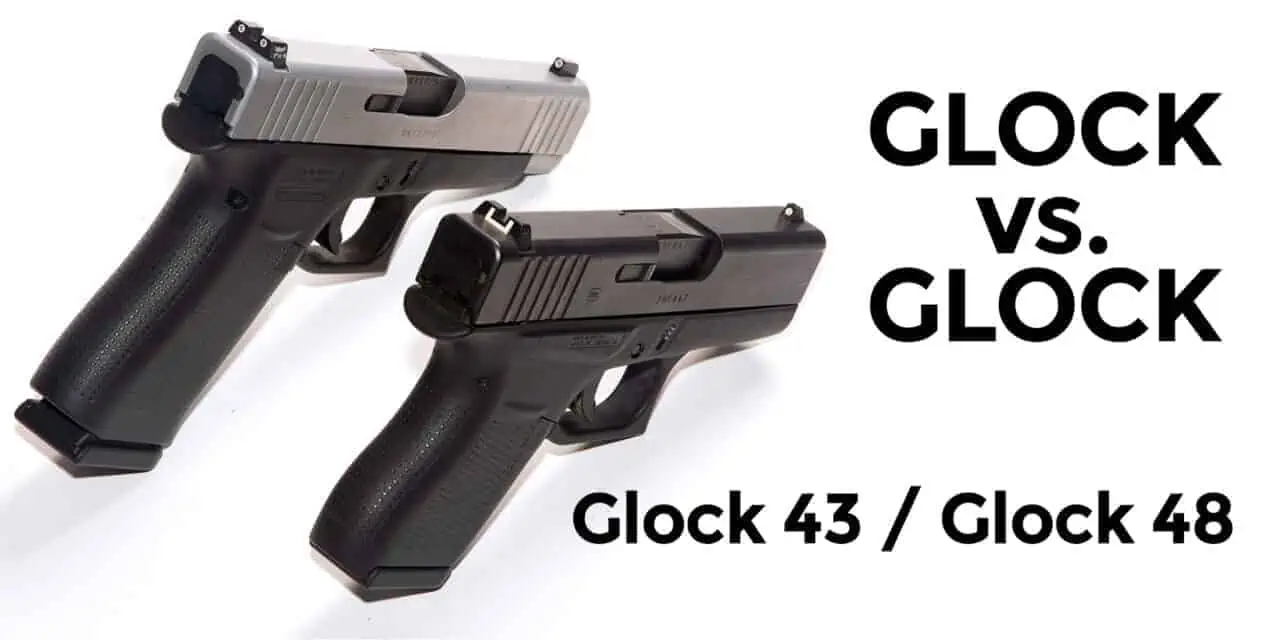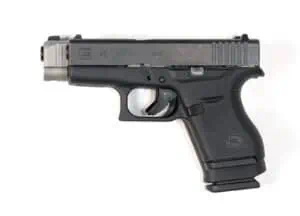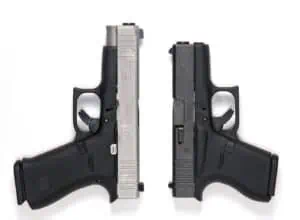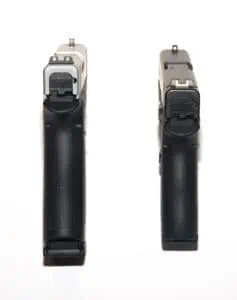Testing The Glock 48 vs Glock 43
Two major trends have taken over the civilian concealed carry market since the introduction of the Glock 19 in 1988. The first is the popularity of smaller, pocket-sized guns such as the Ruger LCP. The second is the rise of compact and slim 9mm single stack such as the Sig Sauer P365 and Springfield Armory Hellcat. Glock responded quickly to both these new markets, which is why today we’ll be looking at the Glock 48 vs the Glock 43.
Glock 48 vs Glock 43 Fast Facts
- The Glock 43 and 48 share many internal parts
- The Glock 43 is a larger, 9mm version of the 380 ACP Glock 42
- Glock 48 upscaled the 43 with a longer barrel and a bigger magazine
There are few internal differences in a Glock 48 vs a Glock 43. This is not surprising, as the 9mm Glock 48 is, in many ways, a larger version of the 9mm Glock 43, just with a longer barrel and higher capacity magazine. Aftermarket triggers for the Glock 48 will usually also work with the smaller Glock 43 and the even smaller Glock 42, which is chambered in 380 ACP.
| Caliber | Weight (w/magazine) | Height (w magazine) | Width | Length | Barrel Length | Capacity | |
|---|---|---|---|---|---|---|---|
| Glock 48 | 9x19 Luger | 30.16 ounces | 5.04 inches | 1.10 inches | 7.28 inches | 4.17 inches | 10 rounds |
| Glock 43 | 9x19 Luger | 20.64 ounces | 4.25 inches | 1.06 inches | 6.26 inches | 3.41 inches | 6 rounds |
The biggest difference between a Glock 48 vs a Glock 43 is the size. The Glock 43 is small and well-suited for pocket carry. The Glock 48, however, is much larger and competes with the Glock 19 for in the waist-mounted concealed carry market. The choice of a Glock 48 vs a Glock 43, then, comes down to which method of concealed carry is right for you.
Why You Want A Glock 43 In Your Pocket
We go into pocket carry in more detail over here, but one of the big advantages of carrying a concealed pistol in a pocket is that it is very easy to conceal. At first glance, the small size and light weight of the Glock 43 make it ideally suited for pocket carry. Whie it’s very true that the dimensions of the Glock 43 are small enough to carry in a medium to large size pocket, things change once you start to shoot it.
380 ACP pocket pistols are hard to control even under the best of circumstances. With the model 43, Glock makes this situation even worse by stuffing the added power of the 9mm Luger round into a gun that is very similar to one that shoots 380 ACP. Now to be clear, we had no issues getting rounds on-target with our Glock 43 at ten yards. However, followup shots were noticeably quicker with the larger Glock 48 vs a Glock 43.
Why You Want A Glock 48 On Your Waistband
We went into more detail about the design and features of the Glock 48 when we compared it to the Glock 19, which you can read over here. One of the things we touched on, however, is the ever-expanding amount of accessories for this gun. You can buy a Glock 48 from the factory that is ready to accept a red dot sight. There are a wide variety of holsters from the 48 from companies like Blade-Tech, Dark Star Gear and Safariland. If a red dot isn’t your thing, there are companies like Trijicon and Ameriglo who make aftermarket sights for the Glock 48. The good news is, because of their common heritage, sights that work on a 48 will probably also work with a Glock 43.
Practical Considerations
The Glock 48 was substantially easier to shoot than the smaller 43. The larger frame of the 48 allowed us to get a good firing grip with both hands, and we were able to get rounds on target quickly and easily.
Some of the best research out there on defensive gun usage by armed citizens tells us that it takes at least three hits from a 9mm pistol to stop an armed and determined attacker. This means that a Glock 48 is good against three attackers, assuming you get all your hits. A Glock 43, on the other hand, maxes out at two attackers, and that can be a bit unsettling. If you carry a Glock 43 (or any other pocket pistol, for that matter), carrying a spare magazine might be a good idea.
On the range, the two pistols were very different to shoot. The smaller frame size of the Glock 43 meant we couldn’t wrap all our fingers around the grip, and the lighter weight meant less mass to soak up the recoil. That 1-2 punch of small frame and low mass combined to give us much faster follow up shots with the larger Glock 48 vs the Glock 43. While we didn’t shoot the guns from a bench rest and measure group sizes, both of the guns were able to place all their rounds in a center-torso area at 10 yards while shooting offhand.
Conclusion
While these two guns share many components, they serve two different purposes. The Glock 48 is meant to ride in a holster on your waist, either appendix carry or on your hip, and serve as your everyday carry defensive pistol. The Glock 43, on the other hand, is well-suited to pocket carry or similar situations when the need to be discrete trumps the need for firepower. In the end, it’s not a question of Glock 48 vs Glock 43. Rather, the question is more about how you choose to carry your defensive firearm. Whichever gun you choose, whichever carry method you choose, what will really make the difference when lives are on the line is your mindset and your ability to make the shot. Whichever gun you choose is just a conduit for those two vital skills.





